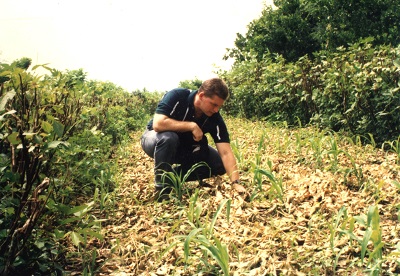Wouldn’t it be great if there was a technology approach that could arrest hunger, fight erosion, promote tree cover, and capture carbon emissions all at once? In southern Philippines, it is happening. By Henrylito D. Tacio.
Courtesy The Edge.
Mindanao, Philippines, 20 May 2019. A south Philippines NGO, the Baptist Rural Life Center (MBRLC), has developed a simple yet sustainable farming scheme that addresses many environmental issues that currently plague our developed world.
The scheme, called Sustainable Agroforest Land Technology (SALT3), it is a development of an existing system developed for difficult terrain, called SAL:T - Sloping Agricultural Land Technology, says Jethro P. Adang, the director of the Davao-based MBRLC.
SALT is a package of soil conservation and food production methods, integrating different soil conservation approaches in a single environment. “Basically, SALT is a method of growing field and permanent crops in rows between lines of nitrogen fixing trees and shrubs,” says Adang. The trees and shrubs are thickly planted in double rows to make hedgerows, to shelter crops.
SALT farming mixes crops and nitrogen-rich hedgerows. Courtesy H Tacio.
And it works. In a demonstration SALT3 farm in Kinuskusan, Bansalan, half the farm is planted with a range of agricultural crops, with nitrogen-fixing trees and shrubs (such as local “ipil-ipil” and “kakawate”, and introduced Flemingia macrophylla, Desmodium rensonii, and Indigofera anil) planted in double rows between them, following the natural contour. And although the approach may seem innovative, it is in fact long established.
“The principle (layout) of SALT3 is the same as that used by the Ifugao tribes in Mountain Province,” Adang explains. “All we are doing is using nitrogen-fixing trees and shrubs instead of rocks.”
The trees are pruned once they are about 2m tall, and the twigs and leaves are piled onto the interlaced alleys, where the agricultural crops are grown. “The leaves of the shrubs make very good nitrogen-rich fertilizer and also add organic matter to the soil,” says Adang.
The SALT scheme produced a range of permanent crops, cereals and vegetables like corn, upland rice, and sorghum, string beans, cucumber, squash and the like. About one third of the growing rows can be devoted to other crops like cacao and coffee, set in intervening rows.
Good, regular, crops result from non-erosive upland cultivation. Courtesy H Tacio.
“By doing this, a farmer can have an income throughout the year,” explains Adang. It means that each month, they can harvest something from the farm. And in addition, any surplus can also provide food for the family.
To further boost sustainability, the SALT3 designers also recommend crop rotation. For instance, strips planted with cereals earlier are best planted with peanuts or winged beans in the next cropping. “This rotation helps to preserve the regenerative properties of the soil,” Adang says, “and avoids problems of infertility typical of some traditional agricultural practices.”
In addition, multi-story cropping may also be practiced, such as planting small crops like black pepper, corn, and lanzones together in one row. And in case some areas of an allotted plot are continually damp or waterlogged, farmers can plant gabi, kangkong and other water-loving crops together in the rows. “This makes use of all the available spaces of any farm,” Adang says.
The new approach also gives a better option for living. If one half of a plot is dedicated to crops, that leaves space where the farmer can also build a house, a fishpond and a vegetable garden. That means building for the future, says Adang; what he calls “the grandchildren project.” “We tell them to plant trees not for yourself but rather for your grandchildren,” he smiles.
These trees can provide fuelwood as well as timber for building and furniture-making purposes. It also offers the opportunity to plant useful secondary tree species, like rattan and giant bamboo among other trees and crops.
But although the SALT approach has been proven to work, uptake is slow.
Traditional hill cultivation often results in rapid erosion. Courtesy Frank A Hilario.
This could be partly because the best regions for it to work effectively, the rural uplands, are traditionally populated by less educated people. “About 60% of our total land area in the country has slopes of 18deg or more and these are classified by our government as uplands,” Adang explains. “These uplands are also being continuously disturbed by (poor) people who are moving to them as land in the lowlands becomes saturated and occupied. There are more people now in the uplands than in recent decades,” he adds.
And most of the lowlanders-turned-upland farmers really don’t know much about upland farming. They cut the trees and employ the slash and burn method of farming they used to practice in the lowlands. The result: soil erosion.
“The (upland) inhabitants are primarily farming families in dire poverty and insecurity,” noted a study commissioned by the National Research Council Project. Subsistence food production, rather than forestry, is their overriding priority.
This results in rapid deforestation, with upland areas losing around 47,000 hectares of forest cover each year, according to Filipino senator Loren Legarda. “We have less than a third of the forest cover we had at the turn of the 20th century,” she warned in a statement recently.
“We are losing 47,000 hectares of forest cover each year” - Senator Legarda.
So can SALT help reverse this cycle of poverty, soil depletion and erosion? Adang and his team think so. As one associate put it, there is not and never will be one system that suits all farmers, and SALT is not a miracle nor a panacea.
“There is no easy way. It takes three to ten years to deplete the soil of nutrients and lose the topsoil and no system can bring depleted, eroded soil back into production in a few short years,” he said.
But if more uplanders take their SALT and put back trees, organic composts and long-term crops into their soil, there is definitely hope. “It is in the uplands were supplementary and additional food sources will be grown,” noted an UNFAO paper, decades ago. “It is in the uplands which will give people temporary elbow room … and it is in the uplands where alternatives for fossil fuel requirements may be produced.”




